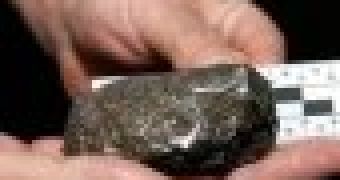A mysterious silvery space object crashed through the roof of a house.
The owners of a New Jersey home were alarmed by the loud noise coming from the bathroom. First, they thought a piece of the ceiling had fallen. Srinivasan Nageswaran and his family were startled to see a chunk of metal that had crashed through the roof and dented the tile bathroom floor.
The object was slightly bigger than a golf ball and about as heavy as a can of soup. It had a silvery color and was made of a stainless-steel alloy that does not occur in nature.
They took the object to the police station for an evaluation and Rutgers University geologist Jeremy Delaney, based on its shape and density, initially pronounced it an iron meteorite. So did other Rutgers geologists and some other independent metals experts.
In April, they performed a more thorough analysis of the "meteorite" using a new variable-pressure scanning electron microscope to establish its composition.
The tests were performed at the American Museum of Natural History in New York, where the Delaney concluded it was just a piece of orbital debris, probably a piece of a satellite, rocket or other spacecraft. "There's huge amounts of material that have been left by the various space programs of the world," he said. Space junk, also called space waste, is made up of objects in orbit around Earth created by humans that no longer serve any useful purpose and have thus been left to float in space.
It may contain anything from entire spent rocket stages and defunct satellites to explosion fragments, paint flakes, dust, and slag from solid rocket motors, coolant released by RORSAT nuclear powered satellites, deliberate insertion of small needles, and other small particles.
The most famous pieces of space junk are a glove of astronaut Ed White, on the first American walk in space, a camera lost by Sunita Williams, a wrench and a toothbrush.
The owners were disappointed by the latest find. "That's the nature of science," said the 46-year-old information technology consultant "If the conclusion from the test says it's not a meteorite, then it's not a meteorite. We have to move forward."
The expert had to admit he had misjudged the space intruder. "I was wrong," he said. "Sneaky little devil."

 14 DAY TRIAL //
14 DAY TRIAL //